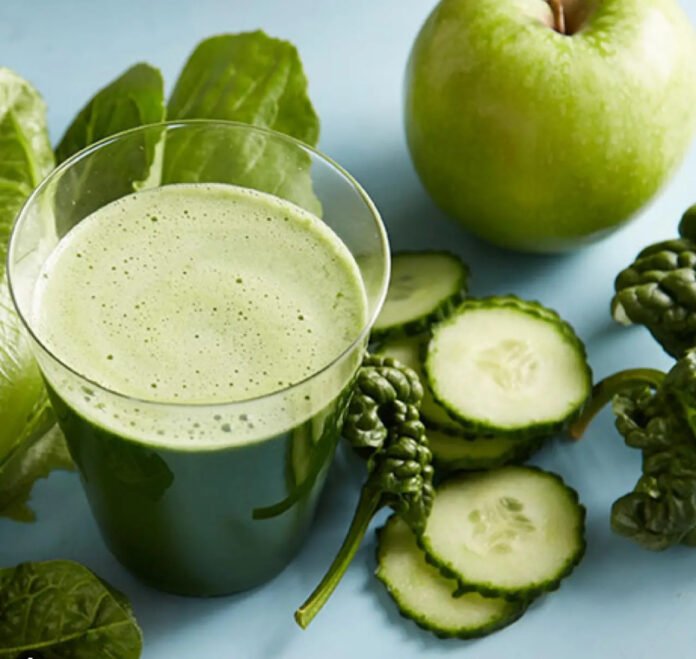Introduction to Green Juice
Green juice has rapidly gained traction in the wellness community, particularly among celebrities who tout its myriad health benefits. At its core, green juice is a beverage primarily composed of green vegetables, fruits, and herbs, meticulously juiced to extract their nutritious essence. Common ingredients include spinach, kale, cucumber, celery, green apples, and ginger, each contributing a unique array of vitamins, minerals, and antioxidants that support overall health.
The preparation of green juice typically involves using a juicer, which mechanically separates the liquid from the pulp, ensuring a concentrated and nutrient-dense drink. Many health enthusiasts prefer homemade versions to control the ingredients and avoid added sugars or preservatives. The process not only preserves essential nutrients but also allows for creativity in combining flavors, making it a customizable option for individual preferences.
The popularity of green juice has surged in recent years, with social media platforms showcasing an influx of vibrant, green drink recipes that appeal to health-conscious individuals. Celebrities often share their juicing routines, endorsing the drink as a convenient way to boost energy levels, detoxify the body, and enhance skin health. This endorsement by public figures has further amplified its appeal, leading to a growing trend where green juice is considered a staple in many wellness regimens.
As more people explore the benefits of juicing, green juice stands out not only as a revitalizing beverage but also as a symbol of a healthier lifestyle. As this trend continues to evolve, it becomes crucial to understand the various health benefits that green juice offers, solidifying its place in the daily routines of individuals striving for optimal well-being.
Nutritional Breakdown of Green Juice
Green juice has gained tremendous popularity, particularly among health-conscious individuals and celebrities, for its impressive nutritional profile. Typically composed of leafy greens, fruits, and other vegetables, green juice is rich in essential vitamins, minerals, and antioxidants that play vital roles in maintaining overall health. One of the key components of green juice is the presence of vitamins A, C, and K, which contribute significantly to various bodily functions.
Vitamin A, found abundantly in ingredients like kale and spinach, is crucial for maintaining healthy vision, skin integrity, and immune function. Vitamin C, often sourced from fruits such as apples and citrus, is a powerful antioxidant that helps protect the body against oxidative stress while boosting collagen production for healthy skin. Meanwhile, vitamin K, primarily obtained from leafy greens, is essential for proper blood clotting and bone health.
Beyond vitamins, green juice is also a source of important minerals. For instance, potassium, often derived from ingredients like cucumber and celery, supports cardiovascular health by regulating blood pressure, while magnesium, present in leafy greens, plays a role in muscle function and energy production.
Antioxidants are another vital aspect of green juice, helping neutralize free radicals and potentially reducing the risk of chronic diseases. Ingredients like wheatgrass and spirulina are known for their high antioxidant content, which may contribute to reduced inflammation and improved overall health.
Common ingredients in green juice include spinach, kale, cucumber, celery, green apples, and herbs like parsley and mint. This combination not only provides a plethora of nutrients but also offers a refreshing taste. The synergy of these components not only appeals to taste buds but also enhances the juice’s health benefits, making it an excellent addition to any diet.
Through the balance of vitamins, minerals, and antioxidants, green juice offers a concentrated source of nutrition that supports the body’s systems and promotes well-being.
Celebrity Endorsements and Personal Testimonials
In the world of health and wellness, few trends have garnered as much attention as green juice, particularly among celebrities. Many well-known figures have shared their personal journeys with green juice, often highlighting its transformative effects on their health and vitality. For instance, actress and lifestyle guru Gwyneth Paltrow is a staunch advocate for incorporating green juice into daily routines. She has been quoted saying, “Green juice is my daily pick-me-up—it energizes me and gives my skin a healthy glow.” Such endorsements resonate with fans, illustrating the potential benefits of a diet rich in greens.
Another prominent figure, singer and actress Jessica Alba, has spoken about her experience with green juice during her busy schedule as a mother and entrepreneur. In her words, “A quick green juice is the easiest way to ensure I’m getting essential nutrients, especially on days I can’t sit down for a proper meal.” Alba’s testimonial underscores the accessibility and convenience of green juice as a nutritious option that fits seamlessly into a hectic lifestyle.
Additionally, renowned chef and television personality Rachael Ray also praises the benefits of green juice. She emphasizes the importance of nutrient-rich ingredients, stating, “I always use kale and spinach in my green juice. They boost my energy and help me stay focused throughout the day.” Her insights reflect a growing trend among celebrities who prioritize health and energy, as green juice continues to make its way into their daily diets.
As celebrity culture persists in influencing public health habits, personal testimonials about green juice serve as motivating factors for many. The common themes of increased energy levels, enhanced wellness, and overall lifestyle improvements presented by these influential figures contribute to the sustainable appeal of this vibrant elixir, placing green juice in the spotlight of health trends.
How to Incorporate Green Juice into Your Routine
Integrating green juice into your daily regimen can be a rewarding experience, enhancing your nutritional intake and offering numerous health benefits. To begin with, establishing a routine is crucial. Many health experts recommend consuming green juice in the morning on an empty stomach to maximize nutrient absorption. This timing allows for a refreshing energy boost that can set a positive tone for the rest of the day. Furthermore, morning consumption may help kickstart your metabolism, making it an ideal time to include this nutrient-rich beverage.
Creating your own green juice can be both fun and customizable. A basic recipe might include leafy greens such as spinach or kale, vegetables like cucumber and celery, and some fruits for sweetness, such as green apples or pears. Adding a squeeze of lemon or a small piece of ginger can enhance the flavor profile while also providing additional health benefits. The flexibility in recipes enables personalization; you can experiment with various ingredients according to your taste preferences or dietary requirements. For example, if you are looking to increase fiber intake, incorporating a small amount of chia or flax seeds can be beneficial.
Sourcing the ingredients is paramount to ensuring quality and freshness. Opting for organic produce can be a wise choice, as it reduces exposure to pesticides and other chemicals, which can otherwise undermine the intended health benefits. Local farmers’ markets or community-supported agriculture (CSA) programs can provide excellent options for acquiring fresh greens and vegetables. One potential challenge of incorporating green juice is balancing flavors to ensure a palatable drink. To achieve this, it is advisable to start with a base of milder greens, gradually introducing more robust flavors as your palate adjusts.
Ultimately, green juice offers a myriad of health advantages, and fine-tuning your recipes and routine can make it an enjoyable part of your daily life.





